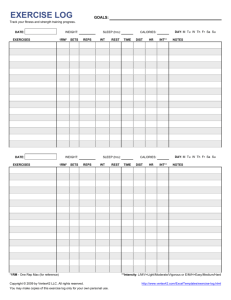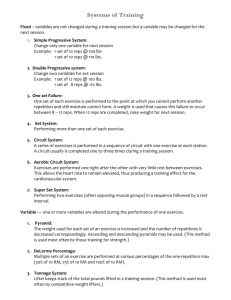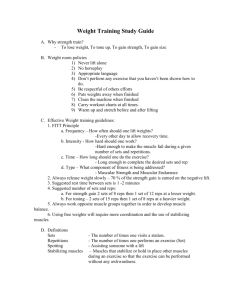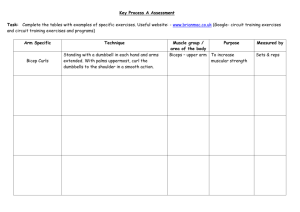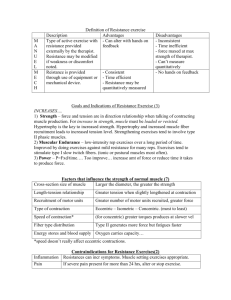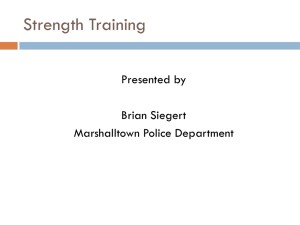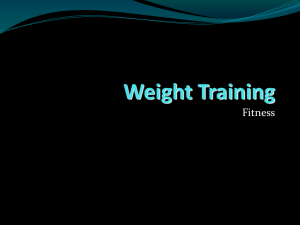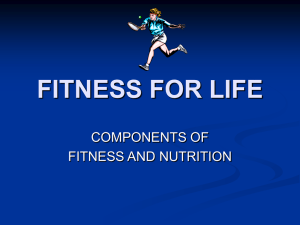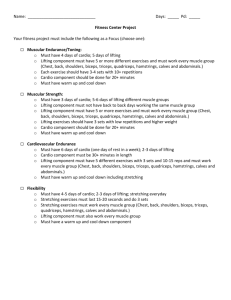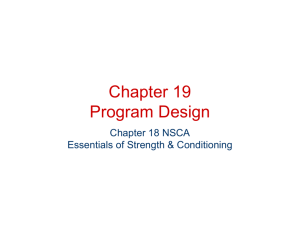Weight Training 149
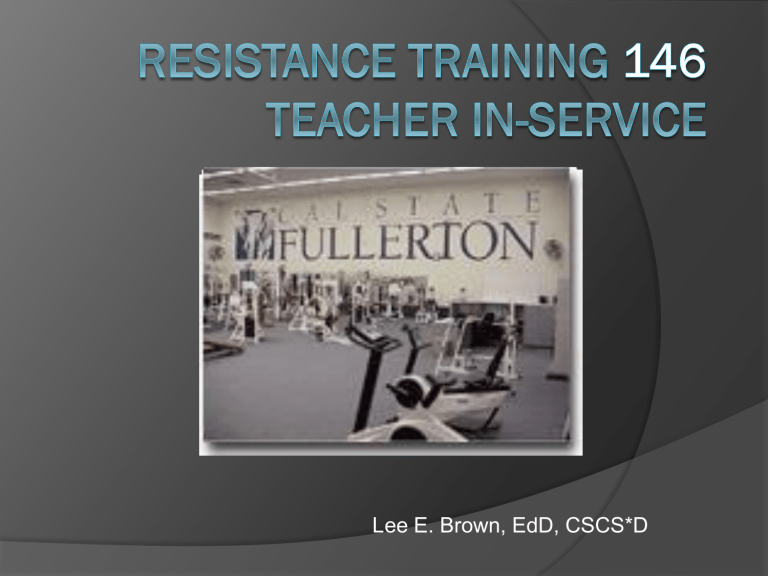
Lee E. Brown, EdD, CSCS*D
Introduction to Strength Training
Understand physiological foundation
Safety
Technique
Modes and actions of exercise
Program design
Testing
1RM
Large muscle groups only
Involves technique
5 or 10RM
Estimate 1RM
Less stressful
Correlation
Handgrip
Exercise Selection
Modes
Isotonic
Isometric
Elastic
Actions
Concentric-shorten
Eccentric-lengthen
Isometric-no change
Spotting
None with machines
None with overhead lifts
None with Olympic lifts
From behind on free weights
Safety first!
Specificity
Individual exercises for goal
Work multi-joint
Know muscles
Know why ?
Periodization
Vary the program
Change exercises and volume
Change intensity
Undulate the program monthly
Progressive Overload
Gentle increases
Specific adaptation to imposed demands
Overload for goal of training
General to Specific
Start with large muscle groups
Start with multi-joint
End with single joints
Small muscles last
Simple to Complex
Exercises ( not daily routine)
Learn simple exercises first
Teach advanced after training age increases
Machines to free weights
Exercise Selection
Core exercises first
Assistance exercises last
Frequency
2 to 3 times per week
Increase with training
Split routines
Vary body parts
Intensity (Load)
60%-85%
Begin low and increase
Choose relative to goals
Repetitions
2-15 reps
Load and reps are inversely related
Load increases-reps decrease
Decrease reps as program increases
Volume
Sets x reps
Multiple vs. single sets
Begin with single and move to multiple
Anything works with beginners
Super Sets
Agonist then antagonist
Saves rest time
Speeds workout
May decrease load
Push/pull
Rest
Energy systems
1:1 to 5:1
Increase rest with load
Begin short and increase to long
Load will determine rest
Velocity
Slow and controlled for strength
2-4 seconds each action
Super slow does not work
Super fast is too much momentum
Explosive for Olympic only
Breathing
In and out
In during eccentric
Out during concentric
Does not matter as long as breathing
Must do valsalva for 1RM
Children and Adolescents
Lots of attention
8-12 reps
2-3 sets
Lots of rest
Major muscle groups
Older Adults
Lots of teaching
8-15 reps
2-3 sets
Lots of rest
Major muscles
Functional
Gender
Females are not just small males
No difference in program design
Females lack testosterone
Females lack hypertrophy
Lower relative resistance
Females 65% strength of males
Age
Maturational age
Chronological age
Training age
Form over Function
No bad exercises!
Only contraindicated exercises
Bad form on exercises
Machines vs. Free Weights
Machines easy to start
Machines teach technique
Machines don’t use balance
Free weights use accessory muscles
Free weights are advanced
Should teach both to everyone
DOMS
Delayed onset muscle soreness
Eccentric actions
Peaks at 48-72 hours
Will resolve after few training sessions
Weight Room
Supervision
Safety
Teach why
Test
4 x 4 Matrix
POWER
STRENGTH
HYPERTROPHY
ENDURANCE
FREQUENCY INTENSITY
1-2 week
85-95%
30-40%
3-4 week
4-6 week
5-7 week
75-85%
60-75%
<60%
VOLUME
1-4 reps
1-2 sets
4-8 reps
3-4 sets
8-12 reps
4-6 sets
12-15 reps
5-7 sets
REST
4-6min
2-3min
30-90s
<30s
Syllabus
Download from my web page
Use as generic template
http://faculty.fullerton.edu/leebrown/

